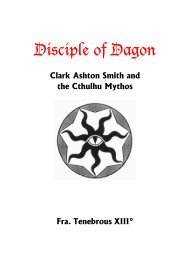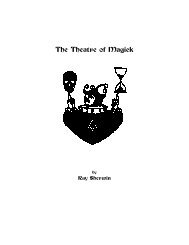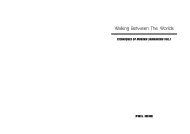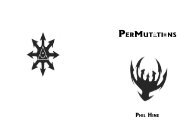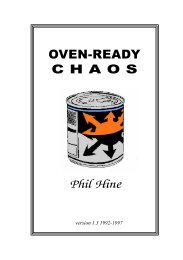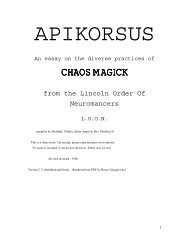Create successful ePaper yourself
Turn your PDF publications into a flip-book with our unique Google optimized e-Paper software.
<strong>Cults</strong> <strong>of</strong> <strong>Cthulhu</strong><br />
H.P Lovecraft and the<br />
Occult Tradition<br />
Fra. Tenebrous
<strong>Cults</strong> <strong>of</strong> <strong>Cthulhu</strong><br />
H.P Lovecraft and the Occult Tradition<br />
by Fra. Tenebrous<br />
First published by Daath Press 1987, as a limited edition <strong>of</strong><br />
123 copies. Text revised 1993. This on-line edition November<br />
1998 with kind permission <strong>of</strong> the author.
H.P LOVECRAFT
“That is not dead which can eternal lie,<br />
And with strange aeons even death may die.”<br />
H. P. Lovecraft, ‘The Nameless City’, 1921<br />
In the 1920’s, an American magazine <strong>of</strong> fantasy and horror<br />
fiction called Weird Tales began to publish stories by a thenunknown<br />
author named H. P. Lovecraft. As his contributions<br />
to the magazine grew more regular, the stories began to form<br />
an internally consistent and self-referential mythology, created<br />
from the literary realisation <strong>of</strong> the author’s dreams and intuitive<br />
impulses. Although he outwardly espoused a wholly rational<br />
and sceptical view <strong>of</strong> the universe, his dream-world experiences<br />
allowed him glimpses <strong>of</strong> places and entities beyond the world<br />
<strong>of</strong> mundane reality, and behind his stilted and <strong>of</strong>ten excessive<br />
prose there lies a vision and an understanding <strong>of</strong> occult forces<br />
which is directly relevant to the Magical Tradition.<br />
Howard <strong>Phil</strong>lips Lovecraft was born on August 20, 1890, in<br />
Providence, Rhode Island, at 454 Angell Street — the house<br />
<strong>of</strong> his maternal grandfather, Whipple V. <strong>Phil</strong>lips. His parents,<br />
Winfield Scott Lovecraft and Sarah Susan <strong>Phil</strong>lips, were <strong>of</strong><br />
English descent, and throughout his life Lovecraft remained a<br />
devoted Anglophile. Winfield Lovecraft, a commercial<br />
traveller, spent much <strong>of</strong> his time away from the family home,<br />
and as a result had little influence on the young Lovecraft.<br />
Three years after his son’s birth, he was admitted to a
psychiatric hospital, where he died in 1898 <strong>of</strong>’ general paralysis<br />
<strong>of</strong> the insane’, the final stage <strong>of</strong> syphilis. As a result, Lovecraft<br />
spent the remainder <strong>of</strong> his formative years under the guidance<br />
<strong>of</strong> his mother and two maiden aunts, who shielded him<br />
completely from the rigours and demands <strong>of</strong> everyday life,<br />
whilst at the same time tormenting him because <strong>of</strong> his supposed<br />
ugliness.<br />
Lovecraft soon began to show signs <strong>of</strong> being ‘different’ —<br />
he could read fluently at the age <strong>of</strong> four, and would spend<br />
hours in his grandfather’s extensive library, studying volumes<br />
<strong>of</strong> history and mythology. His grandfather also introduced him<br />
to local folk tales and myths which he would later draw upon<br />
in his evocations <strong>of</strong> the imaginary New England landscapes<br />
<strong>of</strong> Arkham, Dunwich and Innsmouth.<br />
He began his formal studies at Hope High School,<br />
Providence, but was largely self-educated due to an unstable<br />
constitution, which lead to long periods <strong>of</strong> absence from school.<br />
He preferred the company <strong>of</strong> adults to that <strong>of</strong> other children,<br />
who disliked him because <strong>of</strong> his delicate nature and precocious<br />
intelligence. Instead <strong>of</strong> joining their juvenile games, he<br />
developed his own, interior world <strong>of</strong> the imagination through<br />
writing, and at the age <strong>of</strong> 15 produced his first horror story,<br />
‘The Beast in the Cave’ By 1914, he had submitted a series <strong>of</strong><br />
articles to the United Amateur Press Association and to local<br />
newspapers, ranging in content from astronomy and<br />
philosophy, to his early stories <strong>of</strong> the occult and the<br />
supernatural. Also at this time, he began the epistolary<br />
communications which were to become one <strong>of</strong> the main<br />
pleasures <strong>of</strong> his life. (At one time, Lovecraft had over a hundred<br />
regular correspondents, and in fact, his extant letters<br />
considerably outweigh his fiction - one estimate puts the total<br />
number <strong>of</strong> letters written by Lovecraft at over 100,000.)
However, it was not until 1917 that Lovecraft seriously<br />
considered writing in earnest. The family had been forced to<br />
leave the house in Angell Street due to financial difficulties,<br />
and Lovecraft soon discovered that he was incapable <strong>of</strong> earning<br />
a living. (Indeed, he was to spend the best part <strong>of</strong> his life in a<br />
state <strong>of</strong> financial deprivation and semi-starvation, surviving<br />
on as little as 15 dollars a week.) His mother’s mental and<br />
physical condition declined rapidly, and in 1919 she entered<br />
the Butler Hospital, where she died in May, 1921 after a<br />
protracted illness.<br />
Lovecraft’s short story, ‘Dagon’, written in 1917, was<br />
published by Weird Tales in October, 1923, flue year <strong>of</strong> the<br />
magazine’s appearance. In the same year, he made his first<br />
trip to New York to visit with the poet Samuel Loveman, and<br />
also to meet with Sonia H. Greene, a fellow member <strong>of</strong> the<br />
Amateur Press Association. Lovecraft had been corresponding<br />
with Sonia, a woman several years his elder, since 1921, and<br />
had also worked on revisions <strong>of</strong> some <strong>of</strong> her own writings.<br />
Following their meeting, their friendship deepened and they<br />
were married on March 3, 1924. This new life proved too much<br />
for Lovecraft, however, and they separated after only two years.<br />
Lovecraft found the urban metropolis <strong>of</strong> New York unbearable,<br />
and his feelings <strong>of</strong> revulsion for the city provided the inspiration<br />
for his story, The Horror at Red Hook’. After the break up <strong>of</strong><br />
his marriage, Lovecraft returned to Providence, where he lived<br />
as a semi-recluse in the house <strong>of</strong> his surviving aunt, Anne<br />
<strong>Phil</strong>lips Gamwell. With the exception <strong>of</strong> expeditions <strong>of</strong><br />
antiquarian exploration to various parts <strong>of</strong> the country<br />
(including visits to Boston, Quebec, New Orleans and<br />
<strong>Phil</strong>adelphia), and short trips to examine historical sites within<br />
New England (such as the prehistoric megaliths at Shutesbury,<br />
Massachusetts), he was to remain in Providence for the rest <strong>of</strong><br />
his life.
Following his return to the city <strong>of</strong> his birth, Lovecraft<br />
concentrated exclusively on writing, working through the night<br />
and sleeping during the day, his shutters closed. Embarking<br />
upon long nocturnal ramblings, he would visit the scenes <strong>of</strong><br />
his childhood where he had composed his first stories, and<br />
which held a deep, nostalgic fascination for the adult writer.<br />
In the winter, he seldom left the confines <strong>of</strong> the house due to a<br />
pathological horror <strong>of</strong> temperatures below 70 º F — there is one<br />
anecdote which tells <strong>of</strong> the time that he ventured out when the<br />
temperature read 30 º F, and immediately collapsed needing<br />
medical resuscitation. He displayed a marked aversion to the<br />
sea, suffered from terrible headaches, and physically showed<br />
signs <strong>of</strong> under-nourishment.<br />
He was also subject to particularly vivid and lucid dreams,<br />
suffering from nightmares virtually every other night <strong>of</strong> his<br />
life. During his childhood, he was visited in dream by creatures<br />
which he called ‘the Night Gaunts’. These faceless, bat-winged<br />
apparitions would carry him away to bizarre scenes <strong>of</strong> towering,<br />
pointed mountain tops — an archetypal landscape which was<br />
to find expression in his fiction as ‘the abominable plateau <strong>of</strong><br />
Leng’. And it was during such nocturnal experiences that many<br />
<strong>of</strong> his most powerful images originated — <strong>of</strong>ten transferred to<br />
paper in an manner virtually identical to that <strong>of</strong> ‘automatic<br />
writing’, as was the case in the transcription <strong>of</strong> his prose-poem,<br />
‘Nyarlathotep’. In a letter to Reinhardt Kleiner, dated December<br />
4, 1921, he writes,<br />
“Nyarlathotep is a nightmare — an actual phantasm <strong>of</strong><br />
my own, with the first paragraph written before I fully<br />
awaked. I have been feeling execrably <strong>of</strong> late — whole<br />
weeks have passed without relief from headache and<br />
dizziness, and for a long time three hours was my utmost
limit for continuous work ... Added to my steady ills was<br />
an unaccustomed ocular trouble which prevented me from<br />
reading fine print — a curious tugging <strong>of</strong> nerves and<br />
muscles which rather startled me during the weeks it<br />
persisted. Amidst this gloom came the nightmare <strong>of</strong><br />
nightmares — the most realistic and horrible I have<br />
experienced since the age <strong>of</strong>ten — whose stark hideousness<br />
and ghastly oppressiveness I could but feebly mirror in my<br />
written phantasy...<br />
As I was drawn into the abyss I emitted a resounding shriek<br />
... and the picture ceased. I was in great pain — forehead<br />
pounding and ears ringing — but I had only one automatic<br />
impulse — to write, and preserve the atmosphere <strong>of</strong><br />
unparalleled fright; and before I knew it I had pulled on<br />
the light and was scribbling desperately. Of what I was<br />
writing I had very little idea, and after a time I desisted and<br />
bathed my head. When fully awake I remembered all the<br />
incidents but had lost the exquisite thrill <strong>of</strong> fear — the actual<br />
sensation <strong>of</strong> the presence <strong>of</strong> the hideous unknown. Looking<br />
at what I had written I was astonished by its coherence. It<br />
comprises the first paragraph <strong>of</strong> the enclosed manuscript,<br />
only three words having been changed.” 1<br />
Lovecraft is a particularly interesting case <strong>of</strong> the transmission<br />
<strong>of</strong> ‘occult knowledge’ via dream, in that he was one <strong>of</strong> the few<br />
authors to write effectively on the supernatural without<br />
conscious belief in the material which he was conveying. On<br />
the contrary, he violently denied the possibility <strong>of</strong> the existence<br />
<strong>of</strong> occult phenomena, though he was willing to employ their<br />
manifestation as a fictional device. Nevertheless, this<br />
intellectual denial, expressed in his letters and in conversations<br />
with friends, is belied by the subjective certainty with which<br />
he wrote <strong>of</strong> such matters, as evidenced in his fiction —
indicating a dynamic dichotomy between the rational and<br />
intuitive aspects <strong>of</strong> his psychology.<br />
With the appearance <strong>of</strong> subsequent stories, an underlying<br />
pattern began to appear in Lovecraft’s work. In the central<br />
theme <strong>of</strong> ‘The Call <strong>of</strong> <strong>Cthulhu</strong>’, written in 1926, this design is<br />
clearly revealed. The subject <strong>of</strong> the story is the suggestion that,<br />
at certain times when the conjunctions <strong>of</strong> the stars assume the<br />
correct aspect, certain dark forces can influence sensitive<br />
individuals, giving them visions <strong>of</strong> ‘the Great Old Ones’, godlike<br />
aliens <strong>of</strong> extraterrestrial origin. These entities exist in<br />
another dimension, or on a different vibrational level, and can<br />
only enter this universe though specific ‘window areas’ or<br />
psychic gateways - a concept fundamental to many occult<br />
traditions. <strong>Cthulhu</strong> is the High Priest <strong>of</strong> the Old Ones, entombed<br />
in the sunken city <strong>of</strong> R’lyeh, where he awaits the time <strong>of</strong> their<br />
return. He is described as a winged, tentacled anthropoid <strong>of</strong><br />
immense size, formed from a semi-viscous substance which<br />
recombines after his apparent destruction at the conclusion <strong>of</strong><br />
the tale. The narrative also gives evidence, drawn from various<br />
archaeological and mythological sources, <strong>of</strong> the continuing<br />
existence <strong>of</strong> a cult dedicated to the return <strong>of</strong> the Old Ones, its<br />
exponents ranging from inhabitants <strong>of</strong> the South Seas Islands<br />
to the angakoks <strong>of</strong> Greenland, and practitioners <strong>of</strong> voodoo in<br />
the Southern United States.<br />
Lovecraft also gives a brief description <strong>of</strong> the world after its<br />
re-inheritance by the Great Old Ones:<br />
“The time would be easy to know, for then mankind would<br />
have become as the Great Old Ones; free and wild beyond<br />
good and evil, with laws and morals thrown aside and all<br />
men shouting and killing and revelling injoy. Then the<br />
liberated Old Ones would teach them new ways to shout
and kill and revel and enjoy themselves, and all the earth<br />
would flame with a holocaust <strong>of</strong> ecstasy and freedom.” 2<br />
There is a marked similarity between this passage and the<br />
teachings <strong>of</strong> many actual secret societies <strong>of</strong> the past, including<br />
the Assassins, the Gnostics, and the Templars, but in particular<br />
to the ‘Law <strong>of</strong> Thelema’, as expounded by Lovecraft’s<br />
contemporary, Aleister Crowley. The main distinction is one<br />
<strong>of</strong> moral interpretation — whereas Lovecraft regarded his<br />
ancient gods as essentially evil, Crowley saw the return <strong>of</strong> such<br />
atavistic deities as being in full accord with ‘the progression<br />
<strong>of</strong> the Aeons”.<br />
Following ‘The Call <strong>of</strong> <strong>Cthulhu</strong>’, Lovecraft produced a series<br />
<strong>of</strong> a dozen or more stories which contain the central core <strong>of</strong><br />
the inter-related mythology which later became known as ‘the<br />
<strong>Cthulhu</strong> Mythos’. In these stories, he describes various rites<br />
— surviving on earth since the primordial reign <strong>of</strong> the Old<br />
Ones, and preserved in more recent times in esoteric grimoires<br />
such as the Necronomicon — through which the evocation <strong>of</strong><br />
the alien gods could be effected. In ‘The Case <strong>of</strong> Charles Dexter<br />
Ward’, he suggests that the very roots <strong>of</strong> the magical arts lie in<br />
the ritual veneration <strong>of</strong> these trans-dimensional beings,<br />
attributing a common and unifying source to the many and<br />
diverse strands <strong>of</strong> occult belief. Over the centuries, these<br />
ceremonies have been observed and mis-interpreted in terms<br />
<strong>of</strong> black magic and devil worship.<br />
A point to note here is that Lovecraft never actually used the<br />
term ‘<strong>Cthulhu</strong> Mythos, which was introduced after his death<br />
by his protege, August Derleth. <strong>Cthulhu</strong> is only one <strong>of</strong> a<br />
pantheon <strong>of</strong> deities which includes Yog-Sothoth, Azathoth,<br />
Nyarlathotep, and ShubNiggurath, amongst others. The<br />
manifestations <strong>of</strong> these beings varies from story to story —
sometimes they are described as purely supernatural, while at<br />
other times they appear as extraterrestrials with concrete<br />
physical existence — and sometimes, a particular deity may<br />
be referred to in both ways within the same text. By comparing<br />
the references to each <strong>of</strong> these deities in the Mythos stories, it<br />
is possible to reconstruct their inter-relationship in terms <strong>of</strong> a<br />
hierarchy, and to examine the correspondences between<br />
Lovecraft’s imaginary pantheon and those <strong>of</strong> pre-existing<br />
religious and mythological systems.<br />
Basically, the gods <strong>of</strong> the <strong>Cthulhu</strong> Mythos fall into two<br />
groups, the Great Old Ones and the Elder Gods, though <strong>of</strong> the<br />
latter, only Nodens is mentioned by name. Between Ultimate<br />
Chaos and the Physical World stand Yog-Sothoth and Azathoth,<br />
who share dominion over the lesser deities, pre-human races,<br />
and mankind.<br />
Yog-Sothoth is the outer manifestation <strong>of</strong> the Primal Chaos,<br />
the gate though which those outside must enter. In ‘The<br />
Dunwich Horror’, Lovecraft writes,<br />
“The Old Ones were, the Old Ones are, and the Old Ones<br />
shall be. Not in the spaces we know, but between them,<br />
They walk serene and primal, undimensioned and to us<br />
unseen. Yog-Sothoth knows the gate. Yog-Sothoth is the<br />
gate. Yag-Sothoth is the key and the guardian <strong>of</strong> the gate.<br />
Past, present, future, all are one in Yog-Sothoth. He knows<br />
where the Old Ones broke through <strong>of</strong> old, and where They<br />
shall break through again.”<br />
His order <strong>of</strong> existence parallels the concept <strong>of</strong> the universe<br />
as exposited in Hindu and Oriental mysticism, ‘an All-in-One<br />
and One-in-All <strong>of</strong> limitless being and self. As such, a particular<br />
physical from cannot be ascribed to Yog-Sothoth, though in
‘The Dunwich Horror’, the <strong>of</strong>fspring <strong>of</strong> his mating with Lavinia<br />
Whateley is compared to an octopus, centipede or spider. The<br />
formula <strong>of</strong> evocation <strong>of</strong> Yog-Sothoth is given in ‘The Case <strong>of</strong><br />
Charles Dexter Ward’, wherein it forms part <strong>of</strong> the necromantic<br />
workings <strong>of</strong> the sorcerer, Joseph Curwen.<br />
The British occultist Kenneth Grant has described Yog-<br />
Sothoth as embodying “‘the supreme and ultimate blasphemy<br />
in the form <strong>of</strong> the Aeon (yog or yuga) <strong>of</strong> Set (Sothoth = Set +<br />
Thoth)” 4 . On the qabbalistic Tree <strong>of</strong> Life, Yog-Sothoth can be<br />
attributed to Da’ath, the eleventh (or ‘non’) sephirah, where<br />
the identification is with Choronzon, the Guardian <strong>of</strong> the Abyss<br />
whom Crowley called “the first and deadliest <strong>of</strong> the powers <strong>of</strong><br />
evil”, and whose number is 333, that <strong>of</strong> Chaos and Dispersion.<br />
Elementally, Yog-Sothoth can be considered as the positive<br />
manifestation <strong>of</strong> Fire; magically, to active Spirit, his cardinal<br />
station being the immediate South.<br />
Reigning over the universe is Azathoth,<br />
“the blind idiot god ... the Lord <strong>of</strong> All Things. encircled by<br />
his horde <strong>of</strong> mindless and amorphous dancers, and lulled<br />
by the thin monotonous piping <strong>of</strong> a demoniac flute held in<br />
nameless paws.” 5<br />
Whereas Yog-Sothoth embraces the expanse <strong>of</strong> infinity,<br />
Azathoth represents the opposing principle in that he rules at<br />
the heart <strong>of</strong> Chaos, the central point <strong>of</strong> a universe permeated<br />
by the influence <strong>of</strong> Yog-Sothoth. Their relationship could be<br />
stated as the reconciliation <strong>of</strong> infinite expansion and infinite<br />
contraction. In physical terms, Azathoth manifests as the vast<br />
destructive energy inherent in the atomic particle, which is<br />
unleashed via nuclear fusion. He is the antithesis <strong>of</strong> creation,
the ultimately negative aspect <strong>of</strong> Elemental Fire. Magically,<br />
his attribution is to passive Spirit.<br />
Subservient to ‘the idiot god’ is a group referred to as ‘the<br />
Other Gods’ —the amorphous dancers who attend Azathoth<br />
at the throne <strong>of</strong> Chaos. Their soul and messenger is<br />
Nyarlathotep, ‘the Crawling Chaos’, who mediates between<br />
the Old Ones and their human followers. His avatar manifests<br />
as a human figure dressed in black, with jet black skin but<br />
Caucasian features. In this form he is recognisable as ‘the Black<br />
Man <strong>of</strong> the Witches’ Sabbath’ — an incarnation commonly<br />
associated with Satan. He is depicted in seventeenth century<br />
tracts on witchcraft as a creature with ebony skin, the long<br />
black robe <strong>of</strong> a priest, and a conical hat — a description<br />
substantiated by the testimonies <strong>of</strong> individuals in both Europe<br />
and Lovecraft’s own New England.<br />
Nyarlathotep’s physical appearance also compares quite<br />
strikingly to that <strong>of</strong> the astral entity, Aiwaz, who communicated<br />
the text known as The Book <strong>of</strong> the Law to Aleister Crowley in<br />
Cairo, 1904, thus inaugurating the present Aeon <strong>of</strong> Horus.<br />
Crowley describes Aiwaz as,<br />
“A tall dark man in his thirties, with the face <strong>of</strong> a savage<br />
king, and eyes veiled lest their gaze should destroy what<br />
they saw.”<br />
According to Grant, the Cult <strong>of</strong> Aiwaz “can be traced to a<br />
period that inspired the age-long Draconian Tradition <strong>of</strong> Egypt,<br />
which lingered on into the dark dynasties, the monuments <strong>of</strong><br />
which were laid waste by opponents <strong>of</strong> the elder cult.” It is<br />
interesting to note that Lovecraft himself specifically linked<br />
the worship <strong>of</strong> Nyarlathotep to ‘pre-dynastic Egypt’, in the<br />
eponymously titled prose poem.
The elemental aspect <strong>of</strong> Nyarlathotep is Aether, the<br />
communicating medium <strong>of</strong> interstellar space (or in Lovecraft’s<br />
terminology, ‘The Audient Void’).<br />
Shub-Niggurath is ‘the Black Goat <strong>of</strong> the Woods with a<br />
Thousand Young’ — a title inferring the geometric proliferation<br />
<strong>of</strong> creatures upon the Earth. He is the Horned God <strong>of</strong> the pagan<br />
agricultural societies <strong>of</strong> the ancient world, representing fertility<br />
and sexual energy. In Greek mythology his archetype is Pan,<br />
half-man and half-goat. As Christianity began to replace<br />
paganism, the Pan-image became the prototype for the<br />
Christian devil, and was associated with the practise <strong>of</strong><br />
Satanism, though the worship <strong>of</strong> the Horned God had pre-dated<br />
Christianity by at least a thousand years.<br />
In 1919, Aleister Crowley published a poem entitled ‘A<br />
Hymn to Pan’, in which he evoked this current <strong>of</strong> sexual energy<br />
as it pertains to ceremonial magic, and which he <strong>of</strong>ten<br />
incorporated into his own magical workings. The<br />
exclamation, ‘Io Pan!’, which concludes the poem, corresponds<br />
to the cry <strong>of</strong> ‘Ai! Shub-Niggurath’, which occurs in several <strong>of</strong><br />
Lovecraft’s stories in relation to the worship <strong>of</strong> the goat-god.<br />
This similarity raises the question <strong>of</strong> Lovecraft’s familiarity<br />
with Crowley’s work — he could have seen a copy <strong>of</strong> The<br />
Equinox, the volume <strong>of</strong> collected essays in which-the ‘Hymn<br />
to Pan’ first appeared, in the Widener Library at Harvard, which<br />
obtained a copy in December 1917. However, from passing<br />
references to Crowley in one <strong>of</strong> Lovecraft’s letters, identifying<br />
him with a character in a story by H. R. Wakefield 6 , it would<br />
appear unlikely that Lovecraft knew much <strong>of</strong> ‘the Great Beast’,<br />
except by reputation.<br />
The elemental nature <strong>of</strong> Shub-Niggurath is that <strong>of</strong> Earth,<br />
symbolized by the sign <strong>of</strong> Taurus. His station is the North.<br />
Hastur is ‘the voice <strong>of</strong> the Old Ones’ — an elemental deity
assigned to the Air, or the void <strong>of</strong> outer space. On earth, the<br />
station <strong>of</strong> Hastur is the East, and his sign is Aquarius.<br />
The god Dagon was appropriated by Lovecraft from ancient<br />
Hebraic texts, in which he features as a god <strong>of</strong> the <strong>Phil</strong>istines.<br />
In the Mythos, he is the Progenitor <strong>of</strong> the Seas, the watery<br />
equivalent to Shub-Niggurath and Lord <strong>of</strong> the amphibious Deep<br />
Ones. His elemental attribution is Water, and his number is<br />
777.<br />
<strong>Cthulhu</strong> himself is referred to as ‘the High Priest <strong>of</strong> the Great<br />
Old Ones’. His other titles include, ‘He Who is to Come’, ‘Lord<br />
<strong>of</strong> R’lyeh’, and ‘Lord <strong>of</strong> the Watery Abyss’. <strong>Cthulhu</strong> is the<br />
initiator <strong>of</strong> the dream-visions sent forth to mankind from the<br />
tomb-city <strong>of</strong> R’lyeh. The formula <strong>of</strong> his invocation is supplied<br />
by Lovecraft in the curious ritual phrase, <strong>of</strong> non-human origin,<br />
which is chanted by the worshippers <strong>of</strong> the <strong>Cthulhu</strong> cult:<br />
“Ph’nglui mglw’nafh <strong>Cthulhu</strong> R’lyeh wgah’nagl fhtagn.”<br />
<strong>Cthulhu</strong> represents the Abyss <strong>of</strong> the subconscious or<br />
dreaming mind, and astrologically by the sign <strong>of</strong> Scorpio.<br />
Ceremonially, he is referred to the West (Amenta, or the Place<br />
<strong>of</strong> the Dead in ancient Egyptian religion), and geographically,<br />
to the site <strong>of</strong> R’lyeh in the South Pacific (the exact coordinates<br />
for which are to be found in ‘The Call <strong>of</strong> <strong>Cthulhu</strong>’.)<br />
As already stated, Nodens is the only member <strong>of</strong> the Elder<br />
Gods to be mentioned by name, and Lovecraft gives no further<br />
information concerning him. The sign <strong>of</strong> the Elder Gods is<br />
described as an upright pentagram containing an eye-shaped<br />
sigil. The points <strong>of</strong> the pentagram symbolize the four elements,<br />
plus that <strong>of</strong> Spirit, the fifth or ‘hidden’ element. Combined,<br />
they balance the mono-elemental nature <strong>of</strong> the Old Ones,<br />
suggesting that the Elder Gods may exist on a higher plane
The ‘eye’ suggests the opening if the Ajana Chakra, or Third<br />
Eye, symbolizing the facility <strong>of</strong> astral vision.<br />
In one sense, the beings described above are designated<br />
‘gods’ in as much as they are worshipped by great numbers <strong>of</strong><br />
other beings, both human and non-human. Amongst these are<br />
‘the Elder Races’, who inhabited the Earth in prehistoric times,<br />
and from whose presence man’s very existence derives.<br />
The first <strong>of</strong> these races to visit the Earth was ‘the Old Ones’,<br />
who came down from the stars to build their black stone city<br />
on the continent <strong>of</strong> Antarctica. They are described as having<br />
starfish-shaped heads, and tubular bodies covered with<br />
tentacles and cilia. Their servants are the mindless,<br />
protoplasmic ‘Shoggoths’. In the novel, At the Mountains <strong>of</strong><br />
Madness, Lovecraft records the wars which took place between<br />
the Old Ones and other extra-terrestrial races, at the dawn <strong>of</strong><br />
time. These other groups include the Spawn <strong>of</strong> <strong>Cthulhu</strong>, winged<br />
cephalopods who constructed the now-sunken city <strong>of</strong> R’lyeh.<br />
The Deep Ones, described by Lovecraft in The Shadow over<br />
Innsmouth, are the semi-humanoid, aquatic servitors <strong>of</strong> Dagon.<br />
At certain times in the past, they have ventured onto land and<br />
mated with humans, producing a degenerate <strong>of</strong>fspring who<br />
can be recognised by icthyoid physical characteristics known<br />
as ‘the Innsmouth Look’, after the New England seaport whose<br />
inhabitants had interbred with the Deep Ones.<br />
‘The Whisperer In Darkness’ details a third group <strong>of</strong> nonhuman<br />
entities, which originate from the planet Yuggoth (or<br />
Pluto). They are crab-like creatures, fungoid in substance,<br />
which Lovecraft links with the Mi-Go, or Abominable<br />
Snowman, <strong>of</strong> the Himalayas.<br />
The last type which Lovecraft was to describe in detail is<br />
‘the Great Race’, which occupied the continent <strong>of</strong> Australia<br />
some 150,000 years ago. Unlike the other races mentioned
above, it seems that this group may have been indigenous to<br />
the Earth. Physically, they were cone shaped beings, the head<br />
and organs attached to extendable limbs spreading out from<br />
their apexes. According to the story, ‘The Shadow Out <strong>of</strong> Time’,<br />
the Great Race were able to effect mind transference with any<br />
living being, and had accumulated a vast collection <strong>of</strong><br />
information on the various cultures that exist in the universe.<br />
This completes the pantheon <strong>of</strong> non-human entities. In turn,<br />
the worship <strong>of</strong> the Great Old Ones is continued on earth by<br />
secret societies whose traditions and rituals preserve the hidden<br />
knowledge <strong>of</strong> these Elder Races. Lovecraft documents three<br />
such cults, ‘the Cult <strong>of</strong> <strong>Cthulhu</strong>’, ‘the Esoteric Order <strong>of</strong> Dagon’,<br />
centred in Innsmouth (actually Newburyport, Massachusetts),<br />
and ‘the Starry Wisdom Sect’. In The Haunter <strong>of</strong> the Dark’,<br />
Lovecraft describes how the latter sect held meetings in a<br />
church in Providence, where it communed with an avatar <strong>of</strong><br />
Nyarlathotep via a magical object known as ‘the Shining<br />
Trapezohedron.<br />
The name, ‘Starry Wisdom’, recalls that <strong>of</strong> Crowley’s<br />
‘Argentum Astrum’, or Order <strong>of</strong> the Silver Star, founded in<br />
1907. The ‘Silver Star’ represents Sirius, from which emanates<br />
the magical culTent represented on Earth by the entity, Aiwaz.<br />
Another contemporary <strong>of</strong> Lovecraft’s whose writings contain<br />
many similarities and correspondences is Helena Petrovna<br />
Blavatsky, the famous occultist and theosophist and author <strong>of</strong><br />
The Secret Doctrine, This vast work is in fact an expanded<br />
commentary on The Book <strong>of</strong> Dzyan , itself a fragmentary extract<br />
from the ‘Mani Koumbourm’, the sacred writings <strong>of</strong> the<br />
Dzugarians, an ancient race which inhabited the mountain<br />
regions <strong>of</strong> northern Tibet. These texts tell <strong>of</strong> how the earth<br />
was once possessed by chaotic beings said to have crossed the<br />
gulf from another universe, at a time pre-dating the appearance
<strong>of</strong> man, and goes on to relate how they were expelled from<br />
this universe by the intervention <strong>of</strong> forces allied to the cause<br />
<strong>of</strong> Order. This cosmic history, which details subsequent battles<br />
with other primal life forms, shows an obvious parallel with<br />
that described within the <strong>Cthulhu</strong> Mythos.<br />
In a letter dated March 25, 1933, Lovecraft writes,<br />
“only the other day my New Orleans friend E. H<strong>of</strong>fman<br />
Price ... discovered an intensely picturesque myth-cycle<br />
dealing with the earth’s early aeons, the lost continent <strong>of</strong><br />
Kusha (Atlantis) and Shalmali (Lemuria), & the peopling<br />
<strong>of</strong> the earth from elder planets. There is talk <strong>of</strong> a secret<br />
book in some Eastern shrine, parts <strong>of</strong> which are older than<br />
the earth ... Price assures me it is actual folklore & promises<br />
to send further particulars.” 7<br />
And in another letter 8 , Lovecraft reveals the identity <strong>of</strong> the<br />
secret book as being The Book <strong>of</strong> Dzyan, and identifies the<br />
Eastern shrine with ‘Shamballah’.<br />
Madame Blavatsky died on May 8, 1891, <strong>of</strong> Bright’s disease<br />
— a condition from which Lovecraft also suffered, and which<br />
contributed to his early death.<br />
One explanation <strong>of</strong> the many ‘occult’ correspondences found<br />
in Lovecraft’s fiction has been supplied by Kenneth Grant in<br />
his ‘Typhonian Trilogies’. Grant suggests that the Lovecraftian<br />
grimoire, the Necronomicon, actually exists within the Akasha,<br />
or field <strong>of</strong> Astral Light. This is an etheric reservoir said to<br />
surround the earth, and which retains within its structure the<br />
imprint <strong>of</strong> every event which has occurred since the formation<br />
<strong>of</strong> the planet. It can be accessed at will by those individuals<br />
who possess the necessary psychic ability, and may be<br />
manipulated to provide positive images. It was from the
Akashic records that Blavatsky transmitted The Book <strong>of</strong> Dzayn,<br />
and Crowley transcribed The Book <strong>of</strong> the Cells <strong>of</strong> the Qliphoth<br />
— could it be that Lovecraft may have subconsciously<br />
communicated The Book <strong>of</strong> Dead Names from the same<br />
source?<br />
In his realisation <strong>of</strong> the <strong>Cthulhu</strong> Mythos, Lovecraft also drew<br />
upon a wide range <strong>of</strong> sources from the historical occult<br />
tradition, and from the literary material pertaining to it. In his<br />
essay, ‘Supernatural Horror in Literature’, he mentions<br />
academic works such as Frazer’s The Golden Bough, and<br />
Margaret Murray’s The Witch Cult in Western Europe, as well<br />
as authentic grimoires such as The Keys <strong>of</strong> Solomon and Dr.<br />
John Dee’s Book <strong>of</strong> Enoch, or ‘Liber Logaeth’. He had also<br />
read Waite’s collection <strong>of</strong> medieval texts, The Book <strong>of</strong> Black<br />
Magic and Pacts, MacGregor Mathers’ translation <strong>of</strong> The<br />
Sacred Magic <strong>of</strong> Abra-Melin the Sage, and Cotton Mathers’,<br />
Wonders <strong>of</strong> the Invisible World, which documents the witchcraft<br />
phenomena centred around Salem in 1692. The titles <strong>of</strong> these<br />
volumes are echoed in those which were created by Lovecraft<br />
and his fellow contributors to the <strong>Cthulhu</strong> Mythos: ‘De Vermis<br />
Mysteriis’, ‘The Pnakotic Manuscripts’, ‘Les Cultes des<br />
Ghoules’, and ‘The Book <strong>of</strong> Eibon’.<br />
However, the most important <strong>of</strong> these imaginary tomes is<br />
Lovecraft’s own creation, the ‘Al Azif <strong>of</strong> the mad Arab, Abdul<br />
Alhazred, or, to employ its Latin name, the Necronomicon.<br />
This title, which occurred to Lovecraft during the course <strong>of</strong> a<br />
dream, translates as,<br />
“NEKROS, corpse; NOMOS, law; EIKON, image -<br />
An Image (or Picture) <strong>of</strong> the Law <strong>of</strong> the Dead.”
In a brochure entitled, ‘Chronology <strong>of</strong> the Necronomicon’,<br />
published in 1936, Lovecraft gives a suggested history <strong>of</strong> the<br />
damned book. According to this essay, the original text was<br />
transcribed by the poet Alhazred at Damascus in 730 A.D.<br />
The title, ‘Al Azif, refers to the nocturnal sounds made by<br />
insects, and supposed by Arabs to be the howling <strong>of</strong> demons.<br />
(By the numerology <strong>of</strong> the Qabbalah, its number is 129, which<br />
represents amongst other things, ‘a place <strong>of</strong> ravenous<br />
creatures’, and corresponds with the Egyptian word, ‘Atem’,<br />
‘to annihilate’.) Alhazred had spent ten years alone in the great<br />
southern desert <strong>of</strong> Arabia, the Roba-El-Ehaliyeh or ‘Empty<br />
Space’ <strong>of</strong> the ancients, which was rumoured to be inhabited<br />
by evil spirits. He had explored the ruins <strong>of</strong> Babylon and the<br />
subterranean tombs <strong>of</strong> Memphis, and visited the forbidden city<br />
<strong>of</strong> hem. Beneath the remains <strong>of</strong> a nameless desert town, he<br />
discovered the annals <strong>of</strong> a race older than mankind, which he<br />
set down in the Azif.<br />
In 950 A.D., the book was secretly translated into Greek by<br />
Theodorus <strong>Phil</strong>etas <strong>of</strong> Constantinople, under the title <strong>of</strong> the<br />
Necronomicon, and in 1228, Olaus Wormius made a Latin<br />
transcription. This text was printed twice, once in 15th century<br />
Germany, in black letter, and once in the 17th century, in<br />
Spanish. Shortly after its translation into Latin, the<br />
Necronomicon was banned by Pope Gregory IX, and there is<br />
said to have been no sight <strong>of</strong> the Greek copy since the burning<br />
<strong>of</strong> a library in Salem in 1692. A translation made by Dee was<br />
never printed, and exists only in fragments recovered from the<br />
original manuscript. Of the Latin texts now existing, one is<br />
supposed to be held by the British Museum, and the other by<br />
the Bibliothèque Nationale in Paris. A 17th century copy is in<br />
the Widener Library collection at Harvard. Numerous other<br />
copies probably exist — the book being rigidly suppressed by<br />
the authorities <strong>of</strong> most countries, and by all branches <strong>of</strong>
organised religion.<br />
The mention <strong>of</strong> Dee’s name in connection with the<br />
Necronomicon is interesting in that he was one <strong>of</strong> the few<br />
magical adepts <strong>of</strong> the past who can present us with practical<br />
evidence <strong>of</strong> communication with non-human entities. Dr. John<br />
Dee was the astrologer to Queen Elizabeth I, and worked with<br />
a number <strong>of</strong> scryers, or seers, the most talented <strong>of</strong> which was<br />
the Irishman, Sir Edward Kelly. Through the use <strong>of</strong> a magic<br />
mirror <strong>of</strong> Mayan origin, Kelly made contact with certain spirits,<br />
who communicated through him a series <strong>of</strong> magical ‘Calls’,<br />
or Keys, in a language called ‘Enochian’. This language has<br />
since been studied and analysed by many historians, who<br />
confirm that it is indeed an authentic and consistent idiom,<br />
without resemblance to any other still in existence. It is even<br />
more remarkable that, in recently deciphered passages from<br />
The Book <strong>of</strong> Enoch, words approximating to the names <strong>of</strong> the<br />
Great Old Ones, as they appear in the <strong>Cthulhu</strong> Mythos have<br />
been discovered.<br />
From around 1930, Lovecraft periodically assured his<br />
correspondents that he was about to give up writing, but forced<br />
himself to continue to make the effort to produce new fiction.<br />
In 1935, a year after the completion <strong>of</strong> his final story, The<br />
Shadow Out <strong>of</strong> Time’, he developed an illness which was<br />
finally diagnosed in 1937 as cancer <strong>of</strong> the intestines, by which<br />
time the disease has spread thought his trunk. He was admitted<br />
to the Jane Brown Memorial Hospital, where he died on March<br />
15, 1937, aged 46. He was buried three days later, in the family<br />
plot at Swan Point Cemetery.<br />
After his death, his friend and correspondent August Derleth<br />
formed the Arkham House imprint, with the original aim <strong>of</strong><br />
saving Lovecraft’s work from the obscurity <strong>of</strong> the pulp fiction<br />
magazines in which it had first appeared, and to bring it to the
attention <strong>of</strong> a wider audience. (During Lovecraft’s lifetime,<br />
only one <strong>of</strong> his tales, The Shadow over Innsmouth, had appeared<br />
in book form, produced by an amateur publisher.) In 1939,<br />
Arkham House published the first collection <strong>of</strong> his stories,<br />
The Outsider and Others. Since then, many other writers have<br />
contributed to the growing annals <strong>of</strong> the <strong>Cthulhu</strong> Mythos,<br />
adding their own deities to the pantheon, and creating eldritch<br />
tomes to add to the list <strong>of</strong> blasphemous grimoires. These<br />
authors include many <strong>of</strong> Lovecraft’s personal correspondents<br />
— Clark Ashton Smith, Robert E. Howard, Frank Belknap<br />
Long, Robert Bloch and Derleth himself. More recently,<br />
elements <strong>of</strong> the <strong>Cthulhu</strong> Mythos have featured in the work <strong>of</strong><br />
such writers as Cohn Wilson, Ramsey Campbell, and Brian<br />
Lumley.<br />
The Mythos has also been adopted for practical use by a<br />
number <strong>of</strong> contemporary magical and occult groups and<br />
organizations. Anton La Vey, head <strong>of</strong> the California-based<br />
Church <strong>of</strong> Satan, published his Satanic Rituals in 1972, and<br />
devoted a whole chapter to ‘The Metaphysics <strong>of</strong> Lovecraft’,<br />
including detailed descriptions <strong>of</strong> two Lovecraftian rituals, ‘The<br />
Ceremony <strong>of</strong> the Nine Angles’ and ‘The Call to <strong>Cthulhu</strong>’.<br />
These rituals were transcribed in the original language <strong>of</strong> the<br />
Necronomicon, and translated into English by LaVey’s fellow<br />
Satanist, Michael Aquino 9 .<br />
Another group which employs Lovecratian elements in their<br />
workings is the Black Snake Cult, or ‘La Couleuvre Noire’, a<br />
voodoo coven which combines the rites <strong>of</strong> the left-hand path<br />
with archetypes from the <strong>Cthulhu</strong> Mythos. Its leader, Michael<br />
Bertiaux, is one <strong>of</strong> the chief adepts <strong>of</strong> the Ordo Templi Orientis<br />
Antiqua and its <strong>of</strong>fshoot, the Monastery <strong>of</strong> the Seven Rays,<br />
and was initiated as a Voodoo-Gnostic master in Haiti in 1963.<br />
In his study <strong>of</strong> modern-day voodoo, <strong>Cults</strong> <strong>of</strong> the Shadow,<br />
Kenneth Grant describes a ritual practised by the cult with the
intention <strong>of</strong> making contact with the Deep Ones at a deserted<br />
lake in Wisconsin,<br />
“The Cult <strong>of</strong> the Deep Ones flourishes in an atmosphere <strong>of</strong><br />
moisture and coldness, the exact opposite <strong>of</strong> the fire and<br />
heat generated by the initial ceremonies which include the<br />
lycanthropic rites that evoke the inhabitants <strong>of</strong> the lake.<br />
The participants at this stage actually immerse themselves<br />
in the ice-cold water where a transference <strong>of</strong> sex-magical<br />
energy occurs between priests and priestesses while in that<br />
element.” 10<br />
Through the use <strong>of</strong> this magical rite, Bertiaux claims to have<br />
established contact with these creatures, which “assume an<br />
almost tangible substance”.<br />
Perhaps Lovecraft himself has left us with a rather<br />
unsatisfactory explanation <strong>of</strong> the true provenance <strong>of</strong> the<br />
<strong>Cthulhu</strong> Mythos. Certainly, it appears to hold a great value for<br />
those individuals currently practising ‘the Black Arts’. In the<br />
words <strong>of</strong> Kenneth Grant, the present Outer Head <strong>of</strong> the O.T.O.,<br />
“Lovecraft’s great contribution to the occult lay in his<br />
demonstration — indirect as it may have been — <strong>of</strong> the<br />
power so to control the dreaming mind that it is capable <strong>of</strong><br />
projection into other dimensions, and <strong>of</strong> discovering that<br />
there are doors through which flow — in the form <strong>of</strong><br />
inspiration, intuition and vision —the genuine current <strong>of</strong><br />
creative magical consciousness.” 11<br />
Lovecraft’s occult experiences, disguised as fiction, reveal<br />
the intrusion <strong>of</strong> forces in complete sympathy with those<br />
archetypes and symbols brought through by Blavatsky and
Crowley, whilst in contact with astral entities ‘from beyond’.<br />
He had become the receiver and transmitter <strong>of</strong> hidden<br />
knowledge, though in Lovecraft’s case, the process was<br />
intuitive rather than conscious. The internal self-division thus<br />
engendered may have been the root cause <strong>of</strong> Lovecraft’s mental<br />
and physical peculiarities; or it may have been that these very<br />
traits, which set him apart from the rest <strong>of</strong> society, made him<br />
the ideal focus for the channelling <strong>of</strong> these ultra-mundane<br />
forces.
Notes:<br />
1 Letter no. 94, Selected Letters Volume I, H. P. Lovecraft.<br />
Arkham House, 1965.<br />
2 ‘The Call <strong>of</strong> <strong>Cthulhu</strong>’, The Dunwich Horror and Others,<br />
H. P. Lovecraft. Arkham House, 1963.<br />
3 ‘The Dunwich Horror’, The Dunwich Horror and<br />
Others, H. P. Lovecraft.<br />
4 Outside the Circles <strong>of</strong> Time, Kenneth Grant, page 296.<br />
Muller, 1980.<br />
5 ‘The Haunter <strong>of</strong> the Dark’, The Dunwich Horror and<br />
Others, H. P. Lovecraft.<br />
6 ‘He Cometh and He Passeth By’, H. R. Wakefield.<br />
7 Letter no. 610, to Miss Elizabeth Toldridge, Selected<br />
Letters Volume IV. Arkham House, 1976.<br />
8 Letter no. 604, to Clark Ashton Smith, Selected Letters<br />
Volume IV.<br />
9 The Satanic Rituals, Anton Szandor LaVey. Avon<br />
Books, 1972.<br />
10 <strong>Cults</strong> <strong>of</strong> the Shadow, Kenneth Grant, page 189. Muller,<br />
1975.<br />
11 Outside the Circles <strong>of</strong> Time, Kenneth Grant, page 43.




